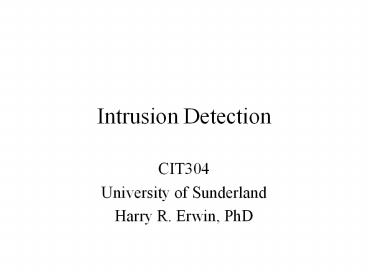Intrusion Detection - PowerPoint PPT Presentation
1 / 17
Title:
Intrusion Detection
Description:
Intrusion Detection CIT304 University of Sunderland Harry R. Erwin, PhD Resources B. Schneier, 2000, Secrets and Lies, Wiley, ISBN: 0-471-25311-1. – PowerPoint PPT presentation
Number of Views:200
Avg rating:3.0/5.0
Title: Intrusion Detection
1
Intrusion Detection
- CIT304
- University of Sunderland
- Harry R. Erwin, PhD
2
Resources
- B. Schneier, 2000, Secrets and Lies, Wiley, ISBN
0-471-25311-1. - E. Amoroso, 1999, Intrusion Detection,
Intrusion.net, ISBN 0-9666700-7-8 - R. G. Bace, 2000, Intrusion Detection, Macmillan
Technical Publishing, ISBN 1-57870-185-6 - We will mostly follow Schneier in this lecture.
3
Intrusion Detection Systems (IDS)
- Network Monitorswatch your network looking for
suspicious behavior - Often but not always based on Audit
- Provide reactive rather than proactive security
- Alert on successful and ongoing attacks
- Need to be accurate in detecting attacks and in
determining that an attack is not underway. - Also may provide diagnosis tools.
4
The False Alarm Problem
- Base rate fallacysuppose you have a test that is
99 accurate. Is this good? - Not necessarily!
- Suppose the real attack rate is 1x10-6 per packet
and there are 100,000,000 packets a day. This
test will generate 10,000 false positives (100
per day) for every real attack it detects (about
4 per year). (Work it out) - If network attacks are rare, a test has to be
powerful to be useful. - Hint this is a likely exam question.
5
The Timely Notification Problem
- You may want to be warned in time to do
something, but - What about slow attacks, running over hours or
days? When should the IDS become suspicious and
tell you? - What about ambiguous evidence? Do you really want
to be warned about borderline cases?
6
The Response Problem
- What do you do if you do hear an alarm? I.e., the
current problem with giving out general warnings
of terrorist activity. - Options include
- Wait
- Collect more information
- Do something
- Hope it goes away
- You may be too busy fighting alligators to do
anything intelligent about draining the swamp.
7
Approaches to Building an IDS
- Misuse detection
- IDS knows what an attack looks like and looks for
it. - Network virus scanner
- Fast, easy to build, has a low false positive
rate. - Misses a lot and is easy to fool.
- Probably will get better over time.
8
Approaches to Building an IDS (II)
- Anomaly detection
- Generates a statistical or neural network model
of the network to figure out what is normal - Sounds an alarm for abnormal activity
- Uses AI
- Bayesian statistics
- Neural networks
- Expert systems
9
Problems with Anomaly Detection
- Does the training data include an attack? Then
hacking will be considered normal. 8( - New things happen on networks all the time.
Successful retraining of an existing AI system to
handle this is a hard problem, worth a PhD. 8( - How can it categorize attacks? That requires
expert input. 8( - False positives are much higher. 8(
- Attack indicators are brittle, so that hackers
can sneak past them. 8(
10
Inline versus Audit-Based IDS
- Should the IDS detect attacks in real-time or
using audit log processing? - Inline will have incomplete data.
- Inline is also computationally expensive.
- Audit log processing is after the fact.
- Audit log formats vary quite a bit.
- A combined approach is feasible, but costly.
11
Host-Based versus Network-Based IDS
- Network-based IDS is basically wire-tapping
- Stealthy
- Operating-system independent
- Host-based IDS uses audit logs
- From workstations, servers, switches, routers,
etc. - Product-specific.
12
Make or Buy
- Do your own monitoring or pay someone else?
- Counterpane
- Qinetiq
- Trust issues particularly important.
- In-house expertise requirement.
13
Honey Pots and Burglar Alarms
- Burglar alarms are resources on the network that
generate an alarm if accessed incorrectly. - Honey pots are burglar alarms dressed up to look
attractive. May incorporate subnetworks and dummy
computers. - Costly.
- Have to look real to the attackers.
- Legality important. Entrapment may be an issue,
so intruders must be warned. - Read http//csrc.nist.gov/publications/secpubs/ber
ferd.ps - See also http//www.strategypage.com/fyeo/howtomak
ewar/default.asp?targetHTIW.HTM
14
Incident Handling Issues
- Be prepared
- Have procedures
- Dont panic
- When to call in the police?
- Expectation management
- Damage control
- Dealing with witch hunts
15
IDS Requirements
- Must be
- Effective
- Easy to use
- Adaptable
- Robust
- Fast
- Efficient
- Safe
16
Future IDS Needs
- Should be
- Accommodating
- Security enhancing
- Scalable
- Realistic
- Hardened
17
Conclusions
- We arent there yet,
- But any IDS system is better than none at all.
- This is the place to be if you want to work on
secure systems development.































